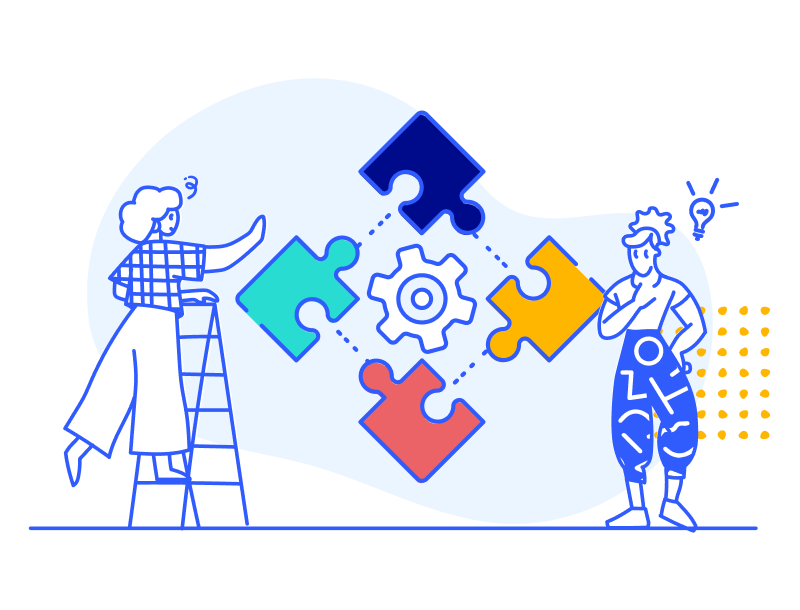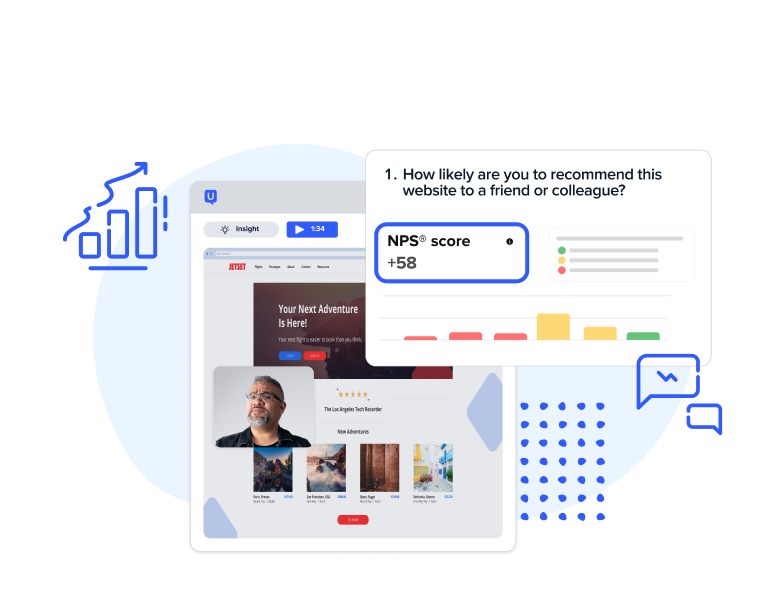
In this guide
Unlocking audience insights: driving smarter decisions across product, marketing, and UX
Unlocking audience insights: driving smarter decisions across product, marketing, and UX

How to collect and apply customer feedback for smarter business decisions
Understanding your customers is critical for developing products, marketing strategies, and user experiences that truly resonate with your target audience. Market and customer insights offer the data-driven knowledge needed to craft personalized strategies, engage effectively, and drive better business outcomes. In this guide, we’ll show you how to collect and analyze audience insights most effectively and turn that understanding into data-driven decisions and actionable strategies that can positively transform your business. Whether you're in product management, marketing, UX, or analytics, this guide will help you unlock the power of audience insights and stay ahead of the competition.

Why audience insights are critical to success
Audience insights are essential to staying competitive and customer-centric. These insights give you an outside-in view of your target customers' true motivations, preferences, and pain points, offering a clear picture of what drives customer behaviors and decisions. When leveraged correctly, audience insights lead to:
- Customer loyalty: By understanding your customer needs, you increase your chances of creating products, experiences, and campaigns that lead to stronger customer satisfaction and loyalty. This provides a critical advantage, particularly in industries with little discernible differentiation.
- Increased innovation and growth: A deeper understanding of the market enables you to meet your audience where they are. By uncovering unmet opportunities, you can continuously fuel your innovation tank and keep ahead of competitors.
- More effective strategies: Audience insights drive cross-functional alignment and help teams develop targeted strategies with the correct market context, ensuring higher engagement, conversion, and customer retention.
- Optimized resource allocation: Knowing what matters most to your audience allows you to prioritize initiatives, reducing wasted effort and investment in less impactful areas.
A continuous feed of audience insights is key to keeping up with the market and fast-evolving customer expectations. By collecting and acting on audience insights, you ensure that your business is always aligned with customer expectations, enabling long-term growth and success.
Challenges in gathering audience insights
Collecting meaningful audience insights can be a complex and resource-intensive process. Teams often face hurdles that hinder their ability to gather and apply customer data effectively:
- Lack of resources or expertise: Teams of all sizes can experience a shortage of research experts, access to proper tools, and a means to operationalize continuous insights collection.
- Fragmented data sources: Customer data often comes from omnichannel touchpoints and systems, creating silos that gate insights access and make it hard to get a complete, unified view of the audience.
- Limited access to diverse customer segments: Gathering feedback from all relevant customer segments, especially niche or global audiences, can be time-consuming and costly.
- Inconsistent or outdated data: Traditional research methods can take too long, leading to outdated insights that no longer reflect current customer needs or are limited to a snapshot in time rather than a dynamic stream of insights required for continuous learning.
- Assumptions and biases: Teams may rely on anecdotal feedback or internal assumptions, rather than gathering fresh, real-time insights directly from customers.
These challenges often result in a limited understanding of your customers, which can negatively impact decision-making and strategic alignment.
ON-DEMAND WEBINAR
Increasing customer satisfaction: turning customer insights into action
What is the impact of decision-making without audience insights?
Neglecting to use audience insights can have significant consequences for businesses, including:
- Missed growth opportunities: Without market signals and a deep customer understanding, you risk missing out on emerging trends, leaving potential opportunities behind.
- Misaligned products and campaigns: If decisions are made without customer insights, products, features, or marketing campaigns may fail to resonate, leading to low engagement, low conversions, and poor product adoption.
- High-risk decisions: Investments and decisions made without the voice of the customer run a higher risk of missing the mark, resulting in not only wasted resources but also unrecoverable brand damage, loss of a competitive advantage, and customer churn.
- Decreased customer satisfaction and loyalty: Products or services that don’t meet customer expectations can lead to frustration, dissatisfaction, and churn, damaging long-term brand loyalty.
- Competitive disadvantage: Companies that don’t use audience insights may fall behind as competitors who continuously innovate and tailor their offerings based on customer feedback gain market share.
The inability to gather and apply audience insights can hinder a company’s ability to innovate, connect with customers, and ultimately thrive in an increasingly competitive market. But fear not, there are simple approaches to establishing best practices for collecting audience insights.

A step-by-step guide: how to effectively collect and apply audience insights
Generating and implementing audience insights require a structured approach. Below, we outline each step of the process, along with practical tips for gathering insights and driving market and customer-informed decision-making.
1. Define your target audience
Objective: Identify and segment the specific customer groups that you need to understand.
Considerations: It’s tempting to define your audience based solely on basic demographics or existing customer segments. However, true audience insights come from a deep customer understanding—not just who they are, but why they act the way they do. Dig deeper into their motivations, frustrations, and aspirations. A well-defined audience persona isn’t just a demographic snapshot; it’s a psychographic and behavioral map that reflects how and why they behave the way they do.
Steps to implement:
- Use existing customer data and market research to define who your ideal customers are. Leverage existing ideal customer profiles (ICP) and personas that your marketing and revenue counterparts have already established.
- Segment your audience based on key criteria such as demographics, behaviors, intent, and pain points. Go beyond your core audience and collect insights from geographic, psychographic, or vertically-segmented audiences to maintain a diverse perspective.
How UserTesting helps:
UserTesting’s global participant network gives you access to diverse, pre-vetted customer segments, ensuring that you can easily reach the right people on demand, whether they are broad or niche audiences.
Expert tip: Don’t just focus on current customers; explore potential customers, too. And as you define your audience, remember that they may have different needs at various stages of their journey. Don’t assume a one-size-fits-all approach will work—segment your audience based on intent, not just identity. This enables you to extract more meaningful, actionable insights.
GUIDE
Stay ahead of the competition: how to use customer insights to outsmart your rivals
2. Establish a clear research objective
Objective: Define the key questions and goals that your research will need to address.
Considerations: Be specific and strategic about the questions you ask and align them with tangible business outcomes. For example, instead of asking “How can we improve our product?” or “What do our customers think?” try “Which three product features are most critical for our customers’ success?” Narrowing the focus will help you cut through the noise and achieve clearer insights that drive actionable change.
Steps to implement:
- Set clear, measurable objectives for your research (e.g., understanding purchasing behavior, uncovering pain points, or testing a new concept).
- Work with your stakeholders to understand their priorities and the key decisions the audience insights need to inform. Consider how those decisions ladder up to target business outcomes.
- Develop hypotheses based on what you currently know about your audience.
How UserTesting helps:
UserTesting’s customizable studies allow you to focus on specific research objectives, enabling you to gather insights that are directly aligned with your business goals and test hypotheses effectively.
Expert tip: Avoid focusing only on what you think you know. Make room for “blind spots” in your objectives—questions you might not have thought to ask but could uncover significant opportunities. A solid research framework includes hypotheses, but also the openness to uncover the unexpected.
3. Choose the right research methodology
Objective: Select the best research methods to gather the data that will help you answer the question at hand.
Considerations: Don’t just choose a research method because it’s familiar or easy. Different insights require different methodologies. Qualitative methods like live interviews provide rich context that enhances customer understanding, while quantitative methods like surveys are necessary for validating trends at scale. It’s essential to combine both approaches to ensure that you’re not only hearing your customers’ voices, but also quantifying their behaviors in a way that’s actionable.
Steps to implement:
- Determine how much time and resources you and your team have to conduct the research. Do you have capacity for multiple interviews? Or do you need to deploy tests at a higher volume and let the respondents complete the study on their own time.
- Determine whether qualitative methods (e.g., interviews, think-out-loud tasks) or quantitative methods (e.g., surveys, interaction tests) best answer your research questions.
- Decide between moderated or unmoderated testing, depending on the complexity, scale, and depth of insights needed.
How UserTesting helps:
The UserTesting platform supports methods for any use case ranging from discovery to customer perception, concept testing, information architecture testing, usability studies, and prototype or live app testing, providing the tools needed to gather both qualitative and quantitative insights.
Expert tip: Remember that no research method is perfect. Even well-structured surveys can miss context, while qualitative interviews might only capture individual experiences. A hybrid approach—starting with qualitative insights to inform quantitative testing—ensures you’re providing a balanced view of customer behavior and make it easier to support better decision alignment across teams.
4. Collect data from real customers
Objective: Gather insights from your target audience using real-time feedback.
Considerations: Be conscious of your sample size and ensure it reflects diverse perspectives. Don’t fall into the trap of collecting feedback solely from your most loyal customers or a homogeneous group. True audience insights are about understanding the entire spectrum of your audience, including those who are on the fringes of your customer base. These “edge cases” often provide critical insights that the mainstream voice may overlook.
Steps to implement:
- Launch your surveys, conduct interviews, or run usability tests with customers that match your target audience.
- Gather both qualitative insights (e.g., emotional responses, pain points) and quantitative data (e.g., behavioral metrics, ratings) to uncover the What and the Why.
- Ensure that results from your study will be collated and viewable from a single document or dashboard.
How UserTesting helps:
UserTesting’s real-time feedback returns the majority of results in just a few hours. Live Conversations, unmoderated testing, and surveys can be launched directly to the UserTesting audience network, and its robust template library will help you hit the ground running.
Expert tip: Real-time feedback is invaluable, but it’s important to balance speed with depth. Don't rush through the data collection process in a hurry to gather numbers. Spend enough time with your participants to let them fully articulate their needs and frustrations. The richer the responses, the more valuable your insights.
5. Analyze the data
Objective: Make sense of the data by identifying patterns and key insights, and package up findings for stakeholder consumption
Considerations: The key is to look for patterns and contexts, not just trends. Often, the most valuable insights lie in the intersections of data points—where different customer segments overlap or where conflicting feedback reveals latent needs. Don’t overlook nuance; sometimes the smallest details can unlock the most profound insights.
Steps to implement:
- Analyze the overall results by reviewing the dashboard (if available) and drilling into responses, transcripts, and videos to identify key insights.
- Categorize the feedback, looking for trends, themes, and anomalies that require your attention.
- Quantify qualitative feedback (e.g., using sentiment analysis) to uncover patterns in customer feelings or behaviors.
How UserTesting helps:
UserTesting’s AI-powered analysis helps you generate key themes and takeaways on-demand. Easily identify patterns across feedback, surfacing key sentiment and insights from video, written, and behavioral insights—without hours of manual analysis.
Expert tip: Use affinity diagrams or mind mapping to synthesize qualitative data. These techniques allow you to visually group feedback into themes, revealing underlying patterns that may not be immediately apparent in individual responses. It’s about making sense of chaos by finding meaning in customer language and behavior.
6. Apply insights to strategy and product development
Objective: Use the audience insights to drive alignment and guide key product, marketing, or customer experience decisions.
Consideration: Turning insights into actionable strategy is often where businesses fall short. Just because you have insights doesn’t mean you’ve fully internalized them for execution. Insights must be communicated clearly and linked directly to business goals. Make sure to align the insights to specific outcomes—whether that’s driving engagement, increasing conversion, or enhancing customer satisfaction. Don’t just present the data—connect the dots for your team to show exactly how these insights impact product, marketing, and customer strategies.
Steps to implement:
- Identify potential implications that the insights you’ve uncovered about your target audience has on your stakeholders’ priorities.
- Translate your insights into actionable recommendations. (For product teams, it may be a recommendation on product prioritization or new market entry; for marketing, it could be about segment-specific messaging to optimize conversions; for UX, it may be about UX/UI improvements that drive recurring usage.)
- Work cross-functionally with teams to implement insights into key product roadmap, marketing campaigns, or customer-experience decisions.
How UserTesting helps:
With UserTesting, you can not only validate product concepts, test messaging, and benchmark user experiences; it accelerates post-test analysis and reporting stages by automating test summaries and data visualization, and allowing you to directly inject key findings into a shared report.
Expert tip: Always align your insights with business goals and make the insights relatable for different teams. Product teams care about functionality, marketing teams need messaging guidance, and the customer experience team wants to know how to build trust. Customize how you present insights to fit each department’s objectives, ensuring that insights drive cross-functional alignment and action.
7. Iterate and optimize based on continuous feedback
Objective: Continuously improve products, services, and strategies by integrating ongoing customer feedback.
Consideration: Audience insights shouldn’t be a “one and done” process. Implementing continuous feedback loops—whether through perception testing, post-launch surveys, or usability studies—keeps you agile and informed about changes in behavior or sentiment. Keep the conversation with your audience ongoing to ensure you’re always aligned with their needs.
Steps to implement:
- Use ongoing user testing to monitor customer reactions and behaviors after launch. Launch testing on a regular interval to benchmark and track shifts over time.
- Implement regular feedback loops to ensure that you remain aligned with changing customer expectations.
- Partner with Product, Marketing, and Customer Experience teams to embed audience insights into the decision-making criteria.
How UserTesting helps:
UserTesting’s continuous feedback tools allow you to run periodic tests and track performance over time, making it easy to adapt your strategies as new data emerges.
Expert tip: Focus on building a feedback culture. Make audience insights an integral part of your company’s DNA. Involve multiple teams in the process—whether it's marketing, product, or customer support—so that everyone is continuously learning from real-time feedback and adjusting strategies in an iterative manner.
Turn insights into action for lasting impact
By following these steps and using UserTesting’s flexible platform, you can collect, analyze, and apply audience insights in a way that drives meaningful business results. Whether you're optimizing user experience, refining marketing strategies, or innovating your product offerings, audience insights will provide the foundation you need to make smarter, customer-driven decisions that return ROI.
